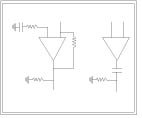Hi
Just building a small line stage and was wondering what is better:
1. a DC blocking cap OR
2. a pretty large electrolytic after the gain resistor ground (-ve input)
Why isn't the second option used much? Does it sound bad? Can you measure much distortion?
To me it makes sense to use the second as the signal does not see the largish output DC blocking cap.
thanks for any comments.
Rob
Just building a small line stage and was wondering what is better:
1. a DC blocking cap OR
2. a pretty large electrolytic after the gain resistor ground (-ve input)
Why isn't the second option used much? Does it sound bad? Can you measure much distortion?
To me it makes sense to use the second as the signal does not see the largish output DC blocking cap.
thanks for any comments.
Rob
Attachments
The second option, DC blocking on the source/preamp output is very common.
The resistor after the DC block is not so common, but in my opinion worth adding if the value is kept high, >=1M0.
If one has just one preamp feeding the power amps (two channels) then all one needs is a pair of high quality plastic dielectric/insulator capacitors. Good Polypropylene and foil of around 10uF, meet most sound requirements. Metalised polypropylene are probably next best.
If the power amps and source are both DC blocked then calculate the filter that the pair of capacitors produces.
Alternatively, arrange a second pair of RCA inputs that bypass the DC blocking cap in the Power Amp and similarly duplicate Pre-amp outputs that bypass the DC blocker. This allows all equipment to interface with all others.
The resistor after the DC block is not so common, but in my opinion worth adding if the value is kept high, >=1M0.
If one has just one preamp feeding the power amps (two channels) then all one needs is a pair of high quality plastic dielectric/insulator capacitors. Good Polypropylene and foil of around 10uF, meet most sound requirements. Metalised polypropylene are probably next best.
If the power amps and source are both DC blocked then calculate the filter that the pair of capacitors produces.
Alternatively, arrange a second pair of RCA inputs that bypass the DC blocking cap in the Power Amp and similarly duplicate Pre-amp outputs that bypass the DC blocker. This allows all equipment to interface with all others.
From a practical view, any DC offset even a few millivolts will cause volume pots to sound noisy and input switching to "thump"
A suitably specified output cap is fine. Remember the cap in the output blocks all DC. Using the cap in the feedback network only reduces the gain to 1 at DC. Not the same thing.
Richie00boys correct as well Work it out
Work it out  Answers on a postcard.
Answers on a postcard.
A suitably specified output cap is fine. Remember the cap in the output blocks all DC. Using the cap in the feedback network only reduces the gain to 1 at DC. Not the same thing.
Richie00boys correct as well
you seem to have inv and non-inv mixed up.robmil said:Why won't the circuit work richie00boy ?
Any answers on the cap to ground version?
The feedback resistor indicates that the circuit is inv. Then the input offset current of the non-inv input should go to ground, but you have it blocked with a cap. That will create an enormous input offset voltage, subject to leakage through the cap.
If you move the feedback resistor to the other input you end up with a non-inv AC amplifier with DC gain set to 1 (+0dB).
But, the opamp (or discrete) can still send an output offset to the next stage.
- Status
- This old topic is closed. If you want to reopen this topic, contact a moderator using the "Report Post" button.
- Home
- Amplifiers
- Solid State
- Simple DC offset question
